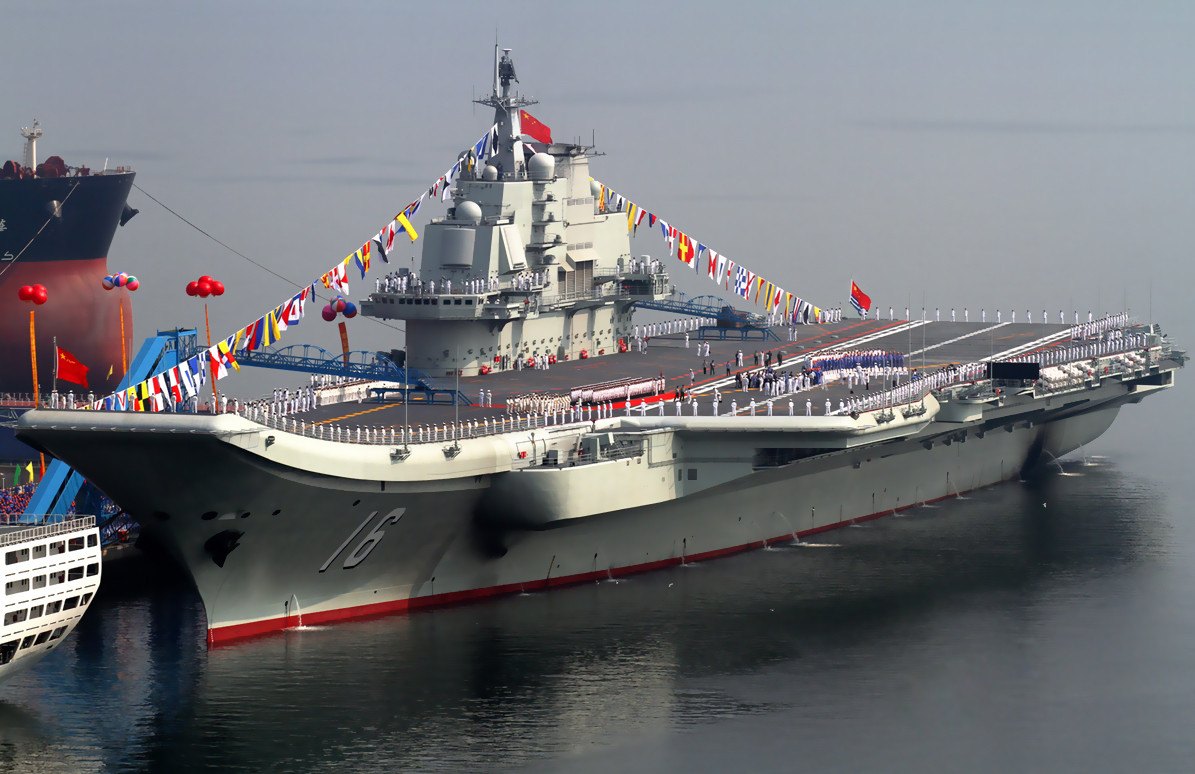By Morgan Deane:
China recently launched the Liaoning in the South China Sea amid continuing tensions in the region. This is the first time they’ve launched the carrier, though they have used it to practice launching and landing aircraft for quite some time. While the Chinese navy is relatively large compared to other nations, their missions often remained limited in scope. Their training and morale in the past were also undermined by political fights and budget cuts. China’s development of an aircraft carrier signals new capabilities to meet new missions.
The Liaoning was purchased from the Russians and entered Chinese service in 2012. The deck doesn’t have an electromagnetic aircraft launch system (EMALS) as of yet, so it is limited to launching lighter aircraft like the J15 and J10, as well as carrier-based helicopters. The full complement for the Liaoning is expected to carry 36 aircraft: 24 J-15 fighters, six anti-submarine warfare (ASW) helicopters, four airborne early warning helicopters, and two rescue helicopters. It comes with several close-in weapon systems to protect against missiles and anti-submarine rocket launchers. Currently, it doesn’t include ground attack missiles and must rely on other ships or ground-based systems to strike those targets.
The ship represents the newest efforts in Chinese reform and innovation. Chinese leaders have increased the budget of the navy, reduced the size of the army, and reorganized the command structure. This means that Chinese naval forces will have a greater amount of modern equipment and form a larger part of their armed forces, with this carrier as one of the central pieces.
China is considered by many analysts to be a traditional land power. This perception is somewhat correct, as China did not have extensive blue water navies throughout much of its history. Blue water navies are described as oceangoing vessels and capital ships designed to operate in blue or deep water. In contrast to blue water navies, a brown water navy consists of small ships operating in swamps, marshes, and seafronts. During some periods, such as the Ming Dynasty, China did have vast treasure fleets and conducted extensive overseas trade. But overall, the perception is correct.
Instead of the previous goals of a brown water navy, such as protecting beaches, traditional search and rescue missions, or smuggling interdiction, China wants to expand its global role with these new and larger ships. China aggressively pursues its interests in the South China Sea by building up the islands, claiming sovereignty over them, and then treating freedom of the sea operations as provocations. They are also increasing the range and sophistication of weapons systems such as new cruise missiles (dubbed “carrier killers” and hyper sonic missiles) and continue to increase the amount of anti-air batteries—all in an effort to make operating in areas like the South China Sea too difficult for the blue water navies of foreign powers, especially the United States.
But not all of their actions are quite as aggressive as the doomsayers would believe. Chinese naval forces have participated in anti-piracy operations along the Horn of Africa. China will likely use this new ship to protect its interests and shipping in places like the Straits of Malacca and the Indian Ocean. They have established bases in Gwadar (Pakistan) and Djibouti near the Red Sea. Not everything is a black and white contest with the Chinese acting with sinister intent.
There is a good chance that China wants this training operation with their carrier to operate the same way as the Great White Fleet. Theodore Roosevelt acted with vigor to expand military and naval power, especially in the early 20th century, in order to protect and promote America’s interests abroad. This included the construction of 11 battleships between 1904 and 1907. Mahan’s naval theories (described in The Influence of Sea Power Upon History) influenced Roosevelt a great deal. In contrast to theories that advocated for commerce raiding, coastal defense, and small brown water ships, the imperative to control the sea required battleships and a blue water navy that could engage and win decisive battles with rival fleets. The mission of the Great White Fleet exemplified America’s new power and intended missions. This fleet of 16 all white battleships sailed around the world and showed the flag between 1907 and 1909. If European analysts interpreted American actions the same way as modern analysts interpret Chinese actions, we might conclude that Roosevelt was aggressively warning his neighbors and had sinister intentions.
China’s development of a new killer anti-ship cruise missile makes their development of a new carrier very ironic as well. Many analysts warn that weapons like the cruise missile will make it so dangerous to operate near China that American forces won’t be able to enter. A short review of its potential impact and the American responses suggest the threat isn’t nearly as large as analysts believe. Building a carrier implies that China might advertise their missiles and A2AD strategy as a game-changer, but China still believes the carrier is an important logistic and symbolic platform to display their national strength. It reinforces the idea that the Chinese need more than narrowly focused new technology; they must contest America’s dominance of blue waters with a fleet of their own. It might even suggest that the Chinese don’t believe in the capability of their weapons system to penetrate American defenses. Or maybe they are simply covering all of their bases. Whatever the exact reason, the reforms and carrier suggest China is serious about their new mission.
Morgan Deane is an OpsLens Contributor and a former U.S. Marine Corps infantry rifleman. Deane also served in the National Guard as an Intelligence Analyst.

















